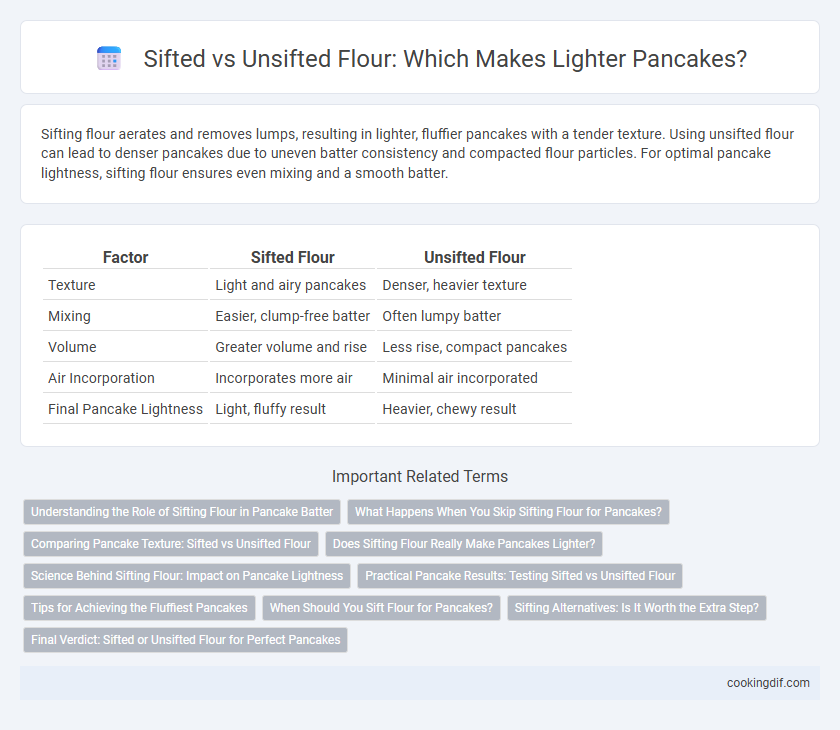Sifting flour aerates and removes lumps, resulting in lighter, fluffier pancakes with a tender texture. Using unsifted flour can lead to denser pancakes due to uneven batter consistency and compacted flour particles. For optimal pancake lightness, sifting flour ensures even mixing and a smooth batter.
Table of Comparison
| Factor | Sifted Flour | Unsifted Flour |
|---|---|---|
| Texture | Light and airy pancakes | Denser, heavier texture |
| Mixing | Easier, clump-free batter | Often lumpy batter |
| Volume | Greater volume and rise | Less rise, compact pancakes |
| Air Incorporation | Incorporates more air | Minimal air incorporated |
| Final Pancake Lightness | Light, fluffy result | Heavier, chewy result |
Understanding the Role of Sifting Flour in Pancake Batter
Sifting flour aerates it, removing lumps and evenly distributing leavening agents, which contributes to a lighter, fluffier pancake texture. Using sifted flour in pancake batter improves the batter's consistency, allowing for better rise and tender crumb formation during cooking. Unsifted flour can result in denser pancakes due to uneven ingredient distribution and potential clumping.
What Happens When You Skip Sifting Flour for Pancakes?
Skipping sifting flour for pancakes can result in dense, uneven batter due to clumps and uneven distribution of leavening agents like baking powder. Sifting aerates the flour, contributing to lighter, fluffier pancakes by promoting better mixing and consistent rising. Using unsifted flour often leads to heavier pancakes with a less tender texture, reducing overall lightness and fluffiness.
Comparing Pancake Texture: Sifted vs Unsifted Flour
Sifted flour creates a lighter, fluffier pancake texture by aerating the flour and breaking up any clumps, resulting in a more delicate crumb. Unsifted flour tends to produce denser pancakes because the retained lumps and compressed flour particles lead to a heavier batter. For optimal pancake lightness and even cooking, using sifted flour enhances batter consistency and texture significantly.
Does Sifting Flour Really Make Pancakes Lighter?
Sifting flour aerates it, breaking up clumps and allowing for easier incorporation with wet ingredients, which can result in lighter, fluffier pancakes. Using unsifted flour may cause denser pancakes due to uneven distribution of ingredients and potential lumps in the batter. Multiple baking experts confirm that while sifting isn't mandatory, it contributes to a more consistent texture and improved pancake lightness.
Science Behind Sifting Flour: Impact on Pancake Lightness
Sifting flour aerates it, breaking up clumps and incorporating air which results in lighter, fluffier pancakes due to improved gluten network formation and even moisture distribution. Unsifted flour is denser, causing batter to be heavier and pancakes to have a tougher texture. The science behind sifting shows that aerated flour promotes better rise and a tender crumb by reducing flour particle size and preventing overmixing.
Practical Pancake Results: Testing Sifted vs Unsifted Flour
Sifting flour before making pancakes incorporates air and removes lumps, resulting in a lighter, fluffier texture compared to unsifted flour, which can produce denser pancakes due to compacted particles. Practical tests show that sifted flour pancakes rise more evenly and have a tender crumb structure, enhancing mouthfeel and overall appeal. Using sifted flour is a simple technique that optimizes batter consistency, maximizing pancake lightness and softness.
Tips for Achieving the Fluffiest Pancakes
Sifting flour aerates it, creating a lighter texture that enhances pancake fluffiness by preventing dense batter clumps. Using sifted flour allows for even ingredient distribution, resulting in tender, airy pancakes with optimal rise. For maximum fluffiness, sift flour before mixing and gently fold ingredients to maintain incorporated air.
When Should You Sift Flour for Pancakes?
Sifting flour for pancakes is essential when aiming for a light and airy texture, as it breaks up clumps and aerates the flour, ensuring even distribution of dry ingredients. Use sifted flour when recipes call for precision and a delicate crumb, particularly in pancake batters with baking powder or baking soda. Unsifted flour can result in denser pancakes due to less incorporated air and uneven mixing of leavening agents.
Sifting Alternatives: Is It Worth the Extra Step?
Sifting flour aerates it, resulting in lighter, fluffier pancakes by removing lumps and evenly distributing leavening agents. Alternatives like whisking flour or using pre-sifted flour can achieve similar results without the extra step, maintaining batter smoothness and consistency. Choosing between sifting and these methods depends on personal preference and time efficiency in pancake preparation.
Final Verdict: Sifted or Unsifted Flour for Perfect Pancakes
Sifted flour incorporates air, resulting in a lighter, fluffier pancake texture compared to unsifted flour, which tends to produce denser pancakes. The final verdict favors sifted flour for achieving that ideal delicate crumb and tender bite. For consistently perfect pancakes, sifting flour before mixing ensures optimal aeration and evenly distributed ingredients.
Sifting flour vs unsifted flour for pancake lightness Infographic

 cookingdif.com
cookingdif.com